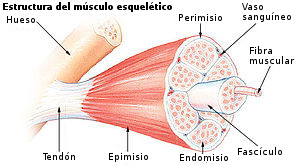10.2. Musculature
The muscular system, together with the skeletal system, are the components of the musculoskeletal system. The muscular system is made up of muscles, organs that have the ability to contract and relax, and thus displace the bone to which they are attached, producing the movement of our body.
The muscle
All the muscles that are part of the locomotor system are made up of skeletal striated muscle tissue, and respond to stimuli in a voluntary and rapid way, controlled by the Central Nervous System. Muscle is made up of fibers formed by the association of several plurinucleated cells.
Each skeletal muscle is an independent organ made up of muscle fibers surrounded by a layer of connective tissue, called the endomysium![]() .
.
Muscle fibers are grouped into muscle bundles surrounded, in turn, by another layer of connective tissue called the perimysium.
Several muscle bundles meet to form the muscle, also surrounded by another layer of thicker connective tissue, the epimysium.
As these protective conjunctive sheaths meet at the ends of the muscles, they are transformed into tendons, which are the point of attachment of the muscles to the bones.
The blood and lymphatic vessels that reach the muscle have to pass through the layers of connective tissue to reach the muscle cells. These cells need to carry out cellular respiration to obtain energy to carry out muscle contraction.

By training.seer.cancer.gov. Loaded by ArcadianDe la traducción Ortisa (Commons: File:Illu muscle structure.jpg) [CC BY-SA 4.0], via Wikimedia Commons
When a command comes from the nervous system for movement to occur, motor nerves join the muscle via motor plates, similar to a synapse, where neurotransmitters are released causing the muscle to contract.
As a muscle contracts, it thickens and decreases the distance between the tendons at its ends, pulling on the bone and moving it, causing the joint to rotate . When it relaxes, it lengthens and the bone returns to its initial position.
The movements are due to the joint action of two or more agonist muscles that act in the same direction, or antagonists, if they act in the opposite direction. Thus, if one contracts, the other relaxes, and vice versa.
This muscle tissue is called striated because of the appearance it presents when seen by the light microscope, where sarcomeres are observed, structures formed by bands of proteins (actin and myosin) that have the capacity to contract.
Activity: Muscle tissue.